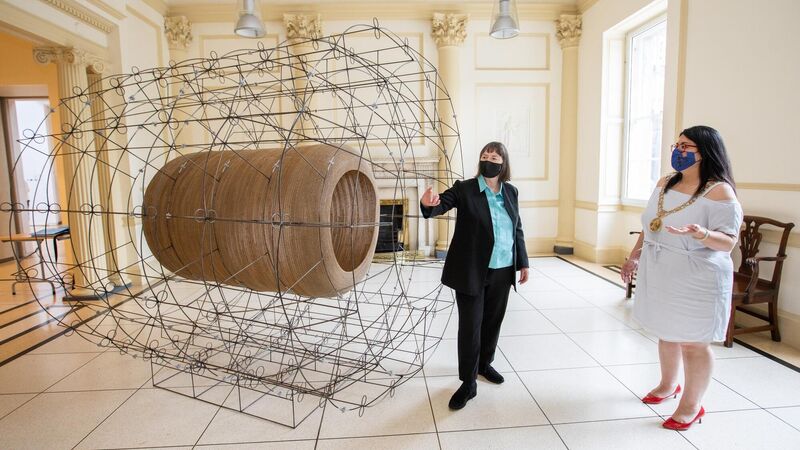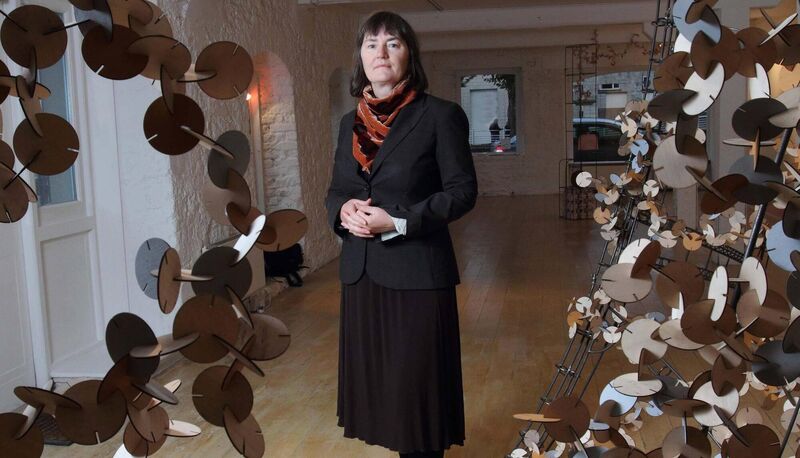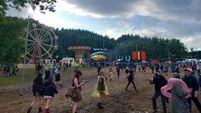Cork In 50 Artworks, No 43: Maud Cotter’s ‘matter of fact’

Cork artist Maud Cotter showing her work ‘matter of fact’ to Lord Mayor of Dublin Hazel Chu at the Hugh Lane Gallery. Picture: Naoise Culhane
Maud Cotter’s ‘matter of fact’ was shown as part of the Cork artist’s solo exhibition ‘a consequence of – a dappled world’ at Dublin City Gallery: The Hugh Lane in June 2021. The work was then acquired for the Hugh Lane’s permanent collection, and will shortly tour to two venues in America, in New York and Jacksonville, Florida.
Cotter made the work over the space of a year at the National Sculpture Factory on Albert Road in Cork, the facility she founded with fellow artists Eilís O’Connell and Vivienne Roche in 1989. “We were classmates in art college,’ she says. “Initially it was us three, and then we broadened it out and invited Danny McCarthy to become involved as well. The energy of so many other people has kept the place going all these years; it’s still there, and still incredibly vibrant.”
‘Matter of fact’ is three metres long and over two metres in diameter, and is constructed of steel, card and plastic cable ties. “The work I’ve been making in recent years is very much an examination of what physical reality is, and ‘matter of fact’ is a kind of provocation on that; it’s asking, what is factual about matter, when it’s in a constant state of change? We tend to see ourselves as separate, but we’re implicated and part of everything else. I think that’s a consciousness we need to take on, in terms of the environment and what challenges us in the future.”
Cotter studied painting and sculpture at the Crawford Municipal College of Art and Design in the early 1970s, when it was still based in Emmet Place. She was one of a generation of young artists who embraced conceptualism and produced brave and ambitious work in a variety of media, both new and traditional.
“We had so many stunning people teaching us at that time,” she says. “John O’Leary was at the heart of the Crawford; Katherine Beug taught us Bauhaus methods of drawing and investigation; and we had the sculptor John Burke teaching us too, of course. It was a very rigorous college experience; we were in there from 9am to 9pm. And then Joseph Beuys came as a visiting lecturer. That was a big influence on me.”

There was a particularly vibrant arts scene in Cork at the time she graduated. “We kind of created our own dynamic,” she says. “Culturally and politically, going into the mid-1970s, Ireland was about to spring forward anyway. We had the Troubles in the North, and Ireland was trying to find its way between the politics of Europe and America. And we were asking; how do we express ourselves? When our economy went down, it was our culture kept us afloat.”
Cotter became well-known early on for her work in stained glass, a medium she helped reinvigorate along with her contemporary James Scanlon. There is a fine example of her work from this period, a brightly coloured stained glass window, in the Triskel Arts Centre on Tobin Street.
She credits a trip to Iceland in 1991 with renewing her interest in sculpture, and she began to explore materials such as steel, glass, cardboard, wax and latex, often to spectacular effect. Always an industrious artist, she exhibited throughout Ireland, Britain and France, and was elected a member of Aosdana in 2000.
Recent years have seen her work and exhibit more often in New York. “I went back and forth for six or seven years,” she says. “I might spend a month in a studio there, and get to know people, often from going to the shops and farmers markets. Wherever I go, I always find my neighbourhood and my community. I settle in. Irish people have a very natural relationship with America anyway. I’ve shown in San Francisco, and I’ve done installations at a place called Point B in Williamsburg, New York, a studio space that opens into a gallery space. This year, again, I’ll be coming and going.”
In May, Cotter will become the first visual artist to show at the Irish Arts Centre in Manhattan, a new facility supported by the Arts Council and Culture Ireland. “The centre cost €60 million to build, it’s a huge achievement. The American perception of Irish culture has largely been about dance, music and literature, but they’re allowing their theatre – an 18 x 10 metre space, to be used for visual art exhibitions. Imagine the impact this will have, when Irish artists are showing there year after year.”

Cotter’s exhibition, curated by Miranda Driscoll, will feature much of the work shown in the Hugh Lane, including ‘matter of fact’, along with sculptures from the artist’s previous exhibitions at Limerick City Gallery and the Dock in Carrick-on-Shannon. “I’ve done a special preparation in the theatre space, creating a unique landscape in which my work will be set. I have these filigree curtains that drop 21 feet. Light will radiate off them, calming the entire space down. People walking in to see the work will do so in stillness; it’s almost like a filmic thing, the way they’ll view it in their heads.”
The exhibition – which Cotter calls ‘a consequence of‘ is already attracting attention. “The Museum of Contemporary Art in Jacksonville, Florida heard about it, and now they’ve invited me to do my first museum show in America. A lot of the work from the Irish Arts Centre show will go down there, but they’ve also commissioned me to do a new installation, which I’ll start working on from 12th July.”
After the isolation of the past years, Cotter is grateful to be back in the thick of things once more. “I love the whole process of preparing an installation, and working with other people in a team. Especially now, after Covid. It feels like we’re re-engaging, doesn’t it?”
- Further information: domobaal.com
- Maud Cotter’s exhibition ‘a consequence of – ‘ opens at the Irish Arts Centre in New York on May 28. Cotter’s installation ‘what was nevers ours to keep’ opens at the Museum of Contemporary Art, Jacksonville, Florida in July.






